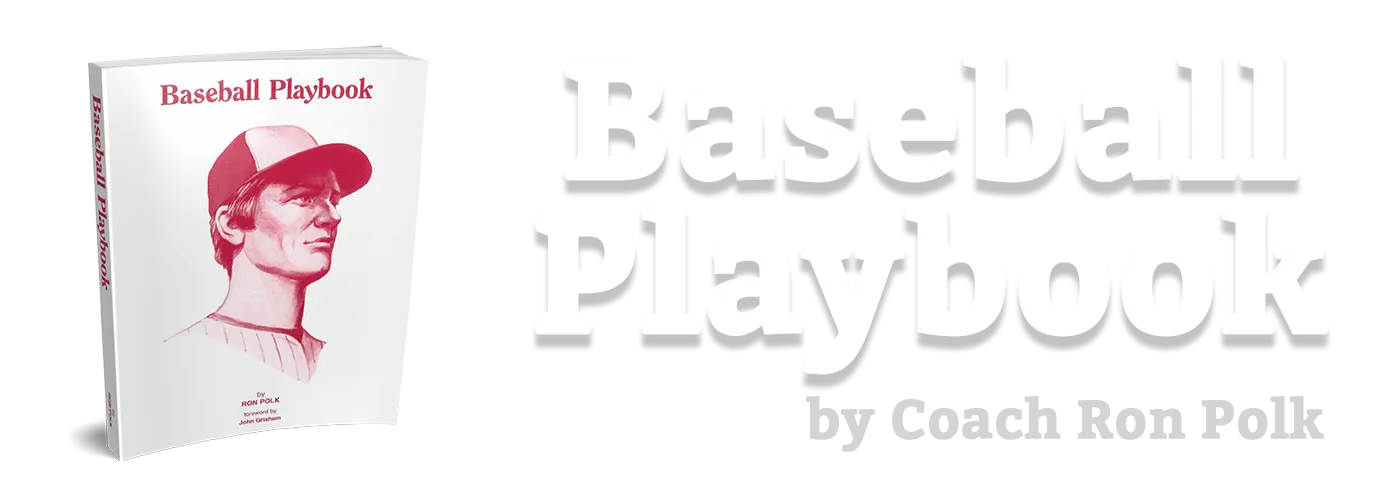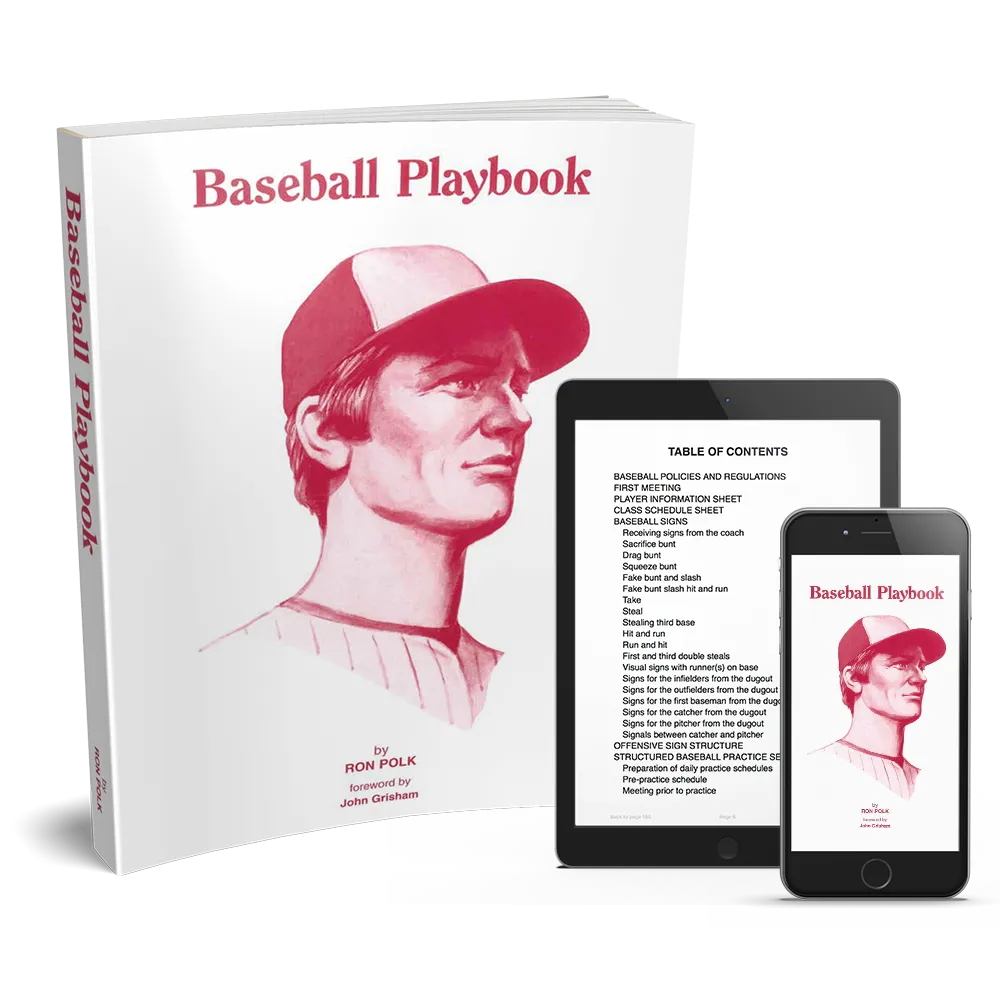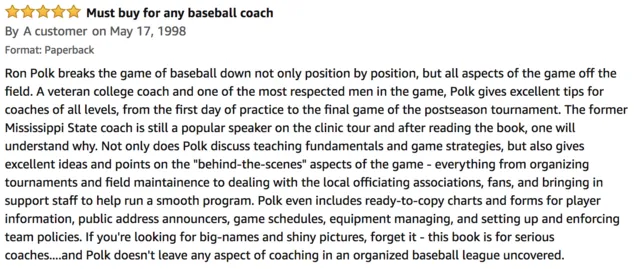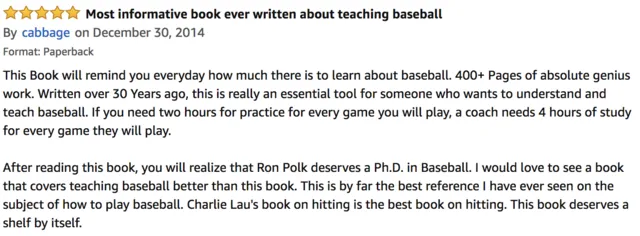History of Coach Polk's Baseball Playbook
In 1972, I became the head coach at Georgia Southern College (now Georgia Southern University) and the year before they were a Division 2 school and became a Division 1 school when I accepted the job there and spent four great years in Statesboro, Georgia. As a young coach, I always felt like it’s important that I pass out a lot of information to our players about what we’re going to do in practice today and everything regarding offenses and defenses, bunt defenses, our first and third plays, our pick off plays, our signals and everything. And I kept passing out more and more papers.
So I’ve been going through reams of paper, giving them a classroom experience and talking about outfield/infield communication, fly ball communication, etc. And so I’d always be in the copy room. Then I’d sit there and copy one page at a time. It seemed like it’d take 30 minutes for every copy. So I was wearing myself out because I wanted the guys to have a lot of information about practice and what we’re going to do that day and the future days so they could read over it and be prepared for practice the next day.
So I got to thinking (this was in 1972 now) there’s got to be a better way to do this. There was no real textbook out there for baseball. There was no book out that really detailed for my players what I wanted them to do both on and off the field. So I started putting my thoughts together when I took the head coaching job at Mississippi State in 1975. I tried putting all this stuff into some type of a form on typewriter (yes, typewriter, there were no computers in 1975). I even had to use a ruler to draw all of my diagrams of the baseball field.
After we had some success at Georgia Southern, I spoke at so many baseball clinics around the country and I’d tell these coaches that I’m putting together a playbook for our players that’s like a textbook you’d see in an English class or a Geography class that they have to study, so that I wouldn’t have to keep passing out reams of paper everyday to try to get them to be prepared for practice or games.
So I started putting all my thoughts together. And from that I came out with the first book. This was around 1978, and I had it bound up before giving a copy of the inaugural playbook to each of my players. I think at that time it was about 175 pages. The playbook was theirs to keep for that year and then I’d take them back because I didn’t want this information traveling around the country. It was really good system because I could tell them exactly what pages to read the day before to prepare for practice tomorrow. For example, if we were going to practice all our time picks at second base, the players could review the signal, the response, the timing, etc. before we ever taught it to them on the field. I would tell them to be prepared so I don’t have to spend my valuable time teaching things over and over – because at the time I was by myself at Georgia Southern. Finally I picked up an assistant coach my last two years, but I mean basically it became another coach for me. I didn’t have to waste a lot of my time which was a big advantage for me.
After I had put that book together, as I was traveling around the country I would have so many coaches come up and ask “Can I get a copy of that book?” I would say “No, I just have 35 copies for my guys, that’s all I have.” And I remember one coach came up to me and said “I will give you anything for that book, I will pay you any amount of money because it’s got everything I need for my program”. This got me thinking on how this could be a great resource for all of baseball, and it needs to reach more than just my 35 players.
So I got my typewriter out and expanded the book to about 275 pages, covering things like: the first meeting, how to train a first base coach, a third base coach, I mean how to even train a public address announcer, literally everything. All the gamut. Base running, bunting, everything that we do. A big piece was our fundamental drill series: drill series 1 and 2, that a lot of people are still using around the country today in their practices.
After doing this, I finally started selling a lot of books, and I did it all myself. I boxed the books. I sealed the books. I stamped the books. I inventoried the books. I sent out billing for the books. With no advertising whatsoever. It became a word-of-mouth book. The Baseball Playbook became something coaches had to have. This made me feel really good that I created this resource that was able to help other coaches all around the country with their baseball programs.
As I continued to travel around people would say “Coach this is typewritten, why don’t you do it professionally?” So after some thought, I spent two years putting a 572 page book together. I got a professional print company to properly design it and edit it. I believe the first reproduced copy was published in 1981. This was a 572 page book with a cover (The same picture of the ‘Coach’ that is on the cover today).
Around this time, many baseball coaches around the country were teaching baseball coaching classes at their respective colleges and colleges wanted the playbook to use as the course textbook. So I had a guy who I knew do all of the test question for every chapter. I would send the colleges a complimentary copy of the book and test questions so that the coaches in college (who didn’t have much time as it was) were able to get the test questions and answers. They were a big fan as it was huge timesaver for them.
I was selling 5,000 to 6,000 books a year and I was still the publisher while simultaneously running baseball programs at Georgia Southern, Mississippi State, and Georgia over this time period. All the while these publishing companies kept calling me wanting to buy my book and give me the royalties. I decided to stay with it as I wanted to ensure that I had control so I could enure it was done right.
Fast forward to today and we’ve sold over 105,000 books (with no advertising I’ll remind you). It’s the leading textbook ever written in baseball. The next closest one was Walter Alston’s “Complete Book of Baseball” I think it was called. They sold over 25,000. We’ve topped everybody because of the coaches’ response to it – they would even refer to it as their Baseball Bible. It has been an incredible honor to see people continue to appreciate my work use the Baseball Playbook with their programs.
And so that’s basically how it started and it’s been very, very successful and we continue to sell books. No question about it. But I have decided, now that we are in the 21st century, to try and market the Baseball Playbook a little bit for the first time ever. The reason being that as I have aged, I want the book to be able to reach a newer, younger generation of coaches and players. That is what is best about the Baseball Playbook. It is timeless. Yes, we are in a new era, but the last time I checked, these bases are still 90 feet, and the mound is 60 feet 6 inches from home plate. I hope you will find value in the Baseball Playbook, and enjoy using it with your team just as much as I enjoyed making over my many years in the game of baseball.
All the Best,
Ron Polk
THE BASEBALL PLAYBOOK INCLUDES:
- Baseball Policies & Regulations
- Player Meetings & Information Sheets
- Baseball Offensive/Defensive Sign Structure for Game Situations
- Structured Baseball Practice Sessions
- Outfield/Infield Drills
- Fundamental Drill Series 1 & 2
- Bunt Defenses
- Pick-Off Plays
- Fly-Ball Communication
- Baserunning Drills & Fundamentals
- 1B + 3B Coaching Guidelines
- Hitting Mechanics, Fundamentals, and Strategy
- Production Rating System
- Common Mental and Physical Faults & Corrections
- Sacrifice, Drag, and Push Bunting
- Pitching Mechanics, Fundamentals, and Strategy
- Catching Mechanics, Fundamentals, and Strategy
- Infield & Outfield Play
- Game Administration
- Establishing Rapport with Umpires
- Coach-Athlete Communication Systems
- Psychological Considerations in Coaching Baseball
- Baseball Scoring & Statistical Analysis
- Baseball Field Maintenance
- and much more...
Paperback + eBook
- The Baseball Playbook Paperback (a $30 value)
- FREE Shipping!
- The Baseball Playbook eBook (a $20 value)
- Coaching Legends VIP
- Exclusive Bonus Videos of Coach Polk
All for just $30!
Just want the eBook?
- The Baseball Playbook eBook (a $20 value)
- Coaching Legends VIP
- Exclusive Bonus Videos of Coach Polk
All for just $15!












